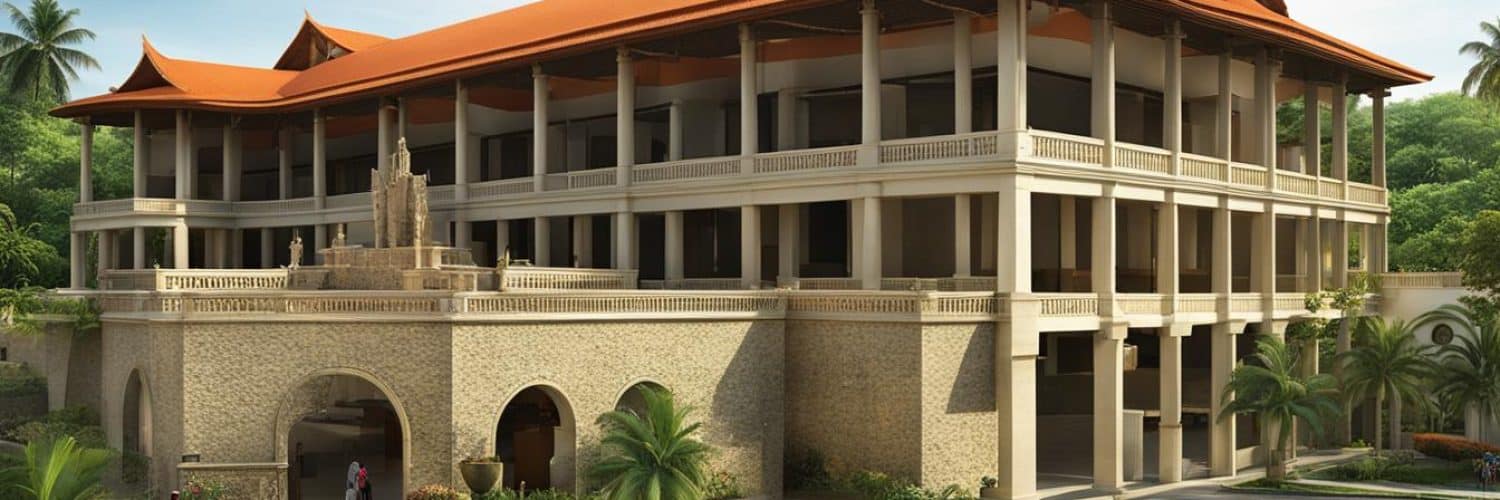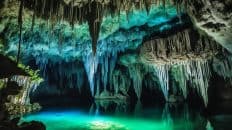Welcome to Bohol National Museum, a cultural heritage site and tourist attraction that offers a fascinating journey into the history and Filipino culture of Bohol, Philippines. Located in Tagbilaran City, Bohol, the museum is housed in the historic Provincial Capitol Building, a testament to the rich Spanish colonial past of the region.
Step inside this architectural gem, which has been restored to its former glory after sustaining damages during the 2013 Bohol Earthquake. As you explore the museum’s three gallery exhibitions, you’ll uncover the captivating stories and treasures of Bohol’s past.
Immerse yourself in the Pagpauli Gallery Exhibition, showcasing the works of National Artist Napoleon Abueva, a celebrated Boholano artist known for his stunning sculptures. Gain insight into the impact of the 2013 earthquake and the resilience of the community at the Pagbanhaw Gallery Exhibition. Finally, marvel at the Natural History of Bohol Gallery Exhibition, where you’ll discover the geological and paleontological wonders that make this island truly unique.
Key Takeaways
- Bohol National Museum is a cultural heritage site and tourist attraction in Tagbilaran City, Bohol, Philippines.
- Housed in the historic Provincial Capitol Building, the museum provides a glimpse into Bohol’s rich history and Filipino culture.
- The museum features three gallery exhibitions, including the works of renowned artist Napoleon Abueva.
- Visitors can explore the Pagpauli Gallery Exhibition, the Pagbanhaw Gallery Exhibition, and the Natural History of Bohol Gallery Exhibition.
- Discover the captivating stories and treasures of Bohol’s past through immersive exhibits and displays.
History and Significance of the Provincial Capitol Building
The Provincial Capitol Building, which now houses the Bohol National Museum, was built in the 19th century during the Spanish colonial period. It served as a tribunal, prison, and living quarters for the Spanish military force. This historic building played a crucial role as the seat of political power in Bohol, reflecting the influence of the Spanish colonial administration.
During the 2013 Bohol Earthquake, the Provincial Capitol Building sustained significant damages. However, recognizing its importance as an architectural and historical gem, the National Museum of the Philippines declared it an Important Cultural Property. As such, the Provincial Government of Bohol generously donated the building for repair and restoration, preserving its historical significance.
After undergoing extensive repairs, the Provincial Capitol Building was reborn as the Bohol National Museum and inaugurated in 2018. This momentous occasion marked the culmination of years of effort to restore the building to its former glory while transforming it into a cultural heritage site for all to visit and explore.
The Provincial Capitol Building stands as a testament to the rich history and heritage of Bohol, representing the resilience and determination of its people. Through careful restoration and the establishment of the Bohol National Museum, this iconic structure continues to serve as a guardian of the past, offering visitors insights into the region’s vibrant history and culture.
In recognition of its historical and cultural significance, the Provincial Capitol Building stands proudly as a symbol of Bohol’s heritage and the importance of preserving and celebrating Filipino history.
Provincial Capitol Building – Then and Now:
| Before | After |
|---|---|
| The seat of political power in Bohol during the Spanish colonial period. | The home of the Bohol National Museum, showcasing the region’s cultural heritage. |
| Served as a tribunal, prison, and living quarters for the Spanish military force. | Repurposed as a center for art, history, and culture. |
| Bore witness to significant events and power dynamics during the Spanish colonial era. | Preserves the history and heritage of Bohol, showcasing the resilience of its people. |
Immerse yourself in the rich history of Bohol by visiting the Provincial Capitol Building, now home to the Bohol National Museum. Explore the exhibits, delve into the region’s cultural heritage, and gain a deeper appreciation for the historical significance of this architectural gem.
Exhibitions at the National Museum Bohol
The National Museum Bohol offers visitors a fascinating insight into the cultural heritage of Bohol through its three gallery exhibitions. These exhibitions showcase the works of renowned artists and significant events in the region’s history.
Pagpauli Gallery Exhibition
The Pagpauli Gallery Exhibition is a must-see showcase of the works of National Artist Napoleon Abueva, a celebrated Boholano artist known for his exceptional sculptures. This exhibition features a comprehensive collection of the late artist’s artworks and tools, providing visitors with a deeper understanding of his artistic genius and contribution to the art scene in the Philippines.
Pagbanhaw Gallery Exhibition
The Pagbanhaw Gallery Exhibition is dedicated to commemorating the 2013 Bohol Earthquake and the remarkable efforts made in the subsequent rebuilding of damaged heritage churches. This exhibition showcases the resilience and determination of the Boholano people in preserving their cultural and architectural treasures, providing visitors with a profound appreciation for the region’s rich history and spiritual significance.
Natural History of Bohol Gallery Exhibition
The Natural History of Bohol Gallery Exhibition takes visitors on a journey through the geological and paleontological wonders of the island. This exhibition presents the unique flora and fauna, as well as the geological treasures and paleontological discoveries that contribute to Bohol’s rich natural heritage. Visitors will gain a deeper understanding of the island’s diverse ecosystems and the importance of preserving these treasures for future generations.
These gallery exhibitions at the National Museum Bohol provide a captivating and educational experience for visitors, offering a unique perspective on the cultural, artistic, and natural aspects of Bohol’s heritage.
Location and Contact Information
If you’re planning a visit to the Bohol National Museum, here’s everything you need to know about its location and how to contact them.
| Location | Contact Information |
|---|---|
| The Bohol National Museum | Address: Km.0, Carlos P. Garcia Ave., Poblacion 3, Tagbilaran City, Bohol |
| Phone: (038) 5019166 | |
| Email: in*********@gm***.com | |
| Social Media: National Museum Bohol Facebook Page |
For any inquiries or further information, don’t hesitate to get in touch with the Bohol National Museum. They will be more than happy to assist you in making your visit a memorable one.
History of the National Museum Tagbilaran
The National Museum Tagbilaran, located on Carlos P. Garcia Avenue, was opened to the public in July 2018. This museum is housed in the reconstructed 1860 Provincial Capitol Building, which had undergone extensive repairs due to the damages caused by an earthquake in 2013. The museum serves as a prominent cultural institution, displaying the results of archaeological excavations and explorations that shed light on the prehistory of Bohol.
At the National Museum Tagbilaran, visitors can marvel at the magnificent artwork exhibits, including the exceptional works of Boholano artist Napoleon Abueva. With a deep commitment to preserving and showcasing the rich cultural heritage of the region, the museum also highlights its involvement in the rehabilitation efforts of the old churches that were severely damaged during the earthquake. It serves as a reminder of the resilience and dedication of the people of Bohol in conserving and safeguarding their cultural properties for future generations.
Through its engaging displays and informative exhibits, the National Museum Tagbilaran invites visitors to embark on a fascinating journey through the history and art of Bohol. Here, the past comes alive, offering a profound understanding and appreciation of the cultural diversity and artistic brilliance that defines this beautiful region.
Visitor Information for the National Museum Bohol
Planning to visit the National Museum Bohol? Here’s everything you need to know before you go:
- Opening hours: The museum is open from Tuesday to Sunday, from 8 AM to 4:30 PM.
- Family-friendly: The National Museum Bohol is a great attraction for families. Its educational exhibits and interactive displays make it an engaging experience for visitors of all ages.
- Average rating: With an average rating of 4.2 based on 47 reviews, the National Museum Bohol is highly regarded by visitors.
- Distance from city center: The museum is conveniently located just 0.5 km from the city center of Tagbilaran, making it easily accessible for tourists and locals alike.
Whether you’re a history enthusiast or simply curious about Filipino culture, a visit to the National Museum Bohol is sure to be a rewarding experience.
Discover the Rich Cultural Heritage of Bohol
“The National Museum Bohol offers a fascinating journey through the history and cultural treasures of the region. It’s a must-visit attraction for anyone looking to immerse themselves in the beauty and heritage of Bohol.” – TripAdvisor Review
Highlights of the National Museum Bohol
The National Museum Bohol offers a diverse range of highlights that showcase the rich cultural heritage and historical significance of Bohol. From archaeological excavation findings to stunning artworks, here are the key attractions and features that make this museum a must-visit:
1. Archaeological Excavation Insights
Delve into the prehistory of Bohol through the National Museum Bohol’s exhibition of archaeological excavation findings. Uncover fascinating discoveries that shed light on the ancient civilizations and early inhabitants of the region. Gain a deeper understanding of Bohol’s cultural roots and the legacy left by its early communities.
2. Artwork Exhibits by Napoleon Abueva
Marvel at the exquisite artworks of Napoleon Abueva, a distinguished Boholano artist and National Artist of the Philippines. The National Museum Bohol proudly presents a special exhibition dedicated to Abueva’s remarkable sculptures and artistic talent. Experience the creativity and artistry of one of the country’s most celebrated artists.
3. Rehabilitation Efforts and Conservation
Witness the museum’s commitment to preserving cultural properties and heritage by exploring the exhibition on rehabilitation efforts. Discover how the National Museum Bohol has been actively involved in the restoration and conservation of old churches damaged during the earthquake. Gain a deeper appreciation for the importance of safeguarding Bohol’s cultural treasures.
4. National Cultural Treasures and Important Cultural Properties
As you explore the National Museum Bohol, you’ll encounter cultural properties that have been recognized as National Cultural Treasures and Important Cultural Properties. These prestigious designations highlight the exceptional value of these artifacts and their significance in the national cultural landscape. Immerse yourself in the rich cultural tapestry that Bohol has to offer.
Immerse yourself in the vibrant heritage and artistry of Bohol at the National Museum Bohol. From uncovering the secrets of the past through archaeological excavations to admiring the masterful works of Napoleon Abueva, each visit promises a captivating experience. Explore the rehabilitation efforts and conservation initiatives that preserve Bohol’s cultural properties, recognized as National Cultural Treasures and Important Cultural Properties. Discover the beauty and significance of Bohol’s cultural heritage at the National Museum Bohol.
Best Time to Visit the National Museum Bohol
The National Museum Bohol offers a fascinating exploration of the cultural heritage of Bohol. To make the most of your visit, it is essential to plan your trip during the museum’s opening hours. The museum welcomes visitors from Tuesday to Sunday, operating from 8 AM to 4:30 PM.
During these hours, you can immerse yourself in the engaging exhibitions and delve into the rich history and artistry of Bohol. Take your time to appreciate the intricate details of the exhibits and learn about the contributions of renowned Boholano artist Napoleon Abueva. From sculptures to artworks, the National Museum Bohol showcases an impressive collection that highlights the unique cultural heritage of the region.
Exploring the museum during its operating hours also allows you to fully experience the guided tours and educational programs available. The knowledgeable staff are on hand to provide insightful information and answer any questions you may have, further enriching your visit.
Visiting the National Museum Bohol during its opening hours ensures that you have ample time to absorb the historical significance and cultural importance of the exhibits. Whether you are a history enthusiast or simply curious about Filipino culture, carving out time within the museum’s schedule guarantees an immersive and enlightening experience.
Nearby Attractions
While visiting the National Museum Bohol, located in Tagbilaran City, you’ll have the opportunity to explore several other attractions nearby. Immerse yourself in the rich cultural and historical heritage of the city and its surrounding areas, and discover the natural wonders and tourist destinations that make Bohol a captivating destination.
Cultural and Historical Sites
Tagbilaran City is home to various cultural and historical sites that offer a glimpse into Bohol’s past. Take a stroll through the Blood Compact Shrine, a monument commemorating the historical event between the Spanish explorer Miguel López de Legazpi and Datu Sikatuna, the chieftain of Bohol. Visit the Baclayon Church, one of the oldest stone churches in the Philippines, and marvel at its stunning architectural beauty. Explore the Dauis Church, known for its intricate ceiling artwork and unique cross-shaped design.
Natural Wonders
Bohol is renowned for its natural wonders, and Tagbilaran City provides easy access to some of the island’s most enchanting sights. Spend a day exploring the enchanting Loboc River, where you can enjoy a cruise through its emerald waters surrounded by lush tropical landscapes. Visit the mesmerizing Chocolate Hills, a geological formation consisting of approximately 1,268 cone-shaped hills. If you’re looking for a unique wildlife encounter, head to the Tarsier Conservation Area and observe the world’s smallest primate, the Philippine Tarsier, in its natural habitat.
| Attraction | Distance from National Museum Bohol |
|---|---|
| Blood Compact Shrine | 4.5 km |
| Baclayon Church | 20 km |
| Dauis Church | 12 km |
| Loboc River | 25 km |
| Chocolate Hills | 57 km |
| Tarsier Conservation Area | 20 km |
Tourist Destinations
Make the most of your visit to Tagbilaran City by exploring the surrounding tourist destinations. Enjoy the breathtaking beaches of Panglao Island, located just a short distance from the city. Swim in the crystal-clear waters, relax on the pristine white sand, and experience the vibrant underwater world through snorkeling or diving. Venture further to Balicasag Island and witness the diverse marine life, including vibrant coral reefs and sea turtles. For a unique cultural experience, visit the Bohol Bee Farm and indulge in organic food, artisanal products, and educational farm tours.
With so much to see and discover, Tagbilaran City and its surrounding areas offer a perfect balance of history, nature, and adventure. Extend your exploration beyond the National Museum Bohol and create lifelong memories in this captivating destination.
Conclusion
The Bohol National Museum, located in the historic Provincial Capitol Building, is a premier destination for history buffs and travelers interested in exploring the rich cultural heritage of Bohol. This museum offers a comprehensive glimpse into the history and heritage of Bohol and Filipino culture, making it a must-visit attraction for those seeking a deeper understanding of the region and its significance in the cultural landscape of the Philippines.
With its exhibitions showcasing the works of renowned artist Napoleon Abueva, visitors to the Bohol National Museum can admire the talent and creativity of this celebrated Boholano artist. From sculptures to other artistic works, the museum provides an opportunity to appreciate the artistic contributions of Abueva and gain insight into the local art scene.
In addition to the artistic exhibitions, the museum also documents the efforts in rehabilitating the heritage churches damaged during the 2013 earthquake. These exhibits highlight the resilience and determination of the local community in preserving and restoring their cultural treasures.
For anyone interested in the history, cultural heritage, and the vibrant Filipino culture, a visit to the Bohol National Museum is a must. Immerse yourself in the stories of the past, marvel at exceptional artworks, and deepen your understanding of the region’s significance. It’s an experience that will leave you with a profound appreciation for the beauty and diversity of Bohol and the Philippines as a whole.
FAQ
Where is the Bohol National Museum located?
The Bohol National Museum is located at Km.0, Carlos P. Garcia Ave., Poblacion 3, Tagbilaran City, Bohol.
What are the exhibitions at the National Museum Bohol?
The National Museum Bohol features three gallery exhibitions: the Pagpauli Gallery Exhibition showcasing the works of National Artist Napoleon Abueva, the Pagbanhaw Gallery Exhibition commemorating the 2013 earthquake, and the Natural History of Bohol Gallery Exhibition showcasing the island’s geological and paleontological treasures.
What is the history of the Provincial Capitol Building?
The Provincial Capitol Building, which now houses the Bohol National Museum, was built during the Spanish colonial period and served as a tribunal, prison, and living quarters for the Spanish military force. It was declared an Important Cultural Property in 2012 and underwent repairs after sustaining damages in the 2013 Bohol Earthquake.
How can I contact the Bohol National Museum?
Visitors can contact the Bohol National Museum through their phone number (038) 5019166 or via email at in*********@gm***.com. The museum can also be reached through their Facebook page, National Museum Bohol.
What is the history of the National Museum Tagbilaran?
The National Museum Tagbilaran is located in the reconstructed 1860 Provincial Capitol Building, which was damaged during an earthquake in 2013. It displays the results of archaeological excavations, artwork exhibits, and highlights the rehabilitation efforts made on the old churches damaged during the earthquake.
What are the opening hours of the National Museum Bohol?
The National Museum Bohol is open from Tuesday to Sunday, from 8 AM to 4:30 PM.
What can I expect to see at the National Museum Bohol?
At the National Museum Bohol, you can see the results of archaeological excavations, artwork exhibits including the works of Napoleon Abueva, and learn about the rehabilitation efforts and conservation of cultural properties in the region.
When is the best time to visit the National Museum Bohol?
The best time to visit the National Museum Bohol is during its operating hours, from Tuesday to Sunday, from 8 AM to 4:30 PM, to fully experience the exhibitions and explore the rich cultural heritage of Bohol.
What are some nearby attractions to the National Museum Bohol?
Visitors to the National Museum Bohol can also explore other cultural and historical sites, natural wonders, and tourist destinations in Tagbilaran City and its surrounding areas.
What is the significance of the Bohol National Museum?
The Bohol National Museum is a premier destination for history buffs and travelers interested in exploring the rich cultural heritage of Bohol. It showcases the works of National Artist Napoleon Abueva, commemorates the 2013 earthquake, and highlights the conservation and preservation of cultural properties in the region.
What can I learn about Filipino culture and history at the Bohol National Museum?
The Bohol National Museum provides insights into the history and heritage of Bohol, as well as Filipino culture. Through its exhibitions and artifacts, visitors can learn about the prehistory of Bohol, the works of renowned artist Napoleon Abueva, and the rehabilitation efforts made on historical structures damaged during the earthquake.














Add comment